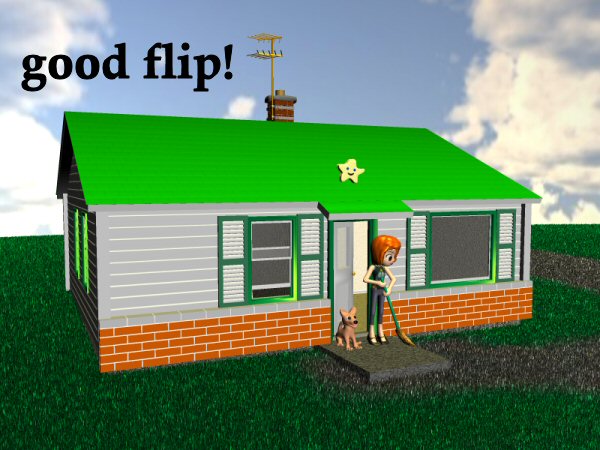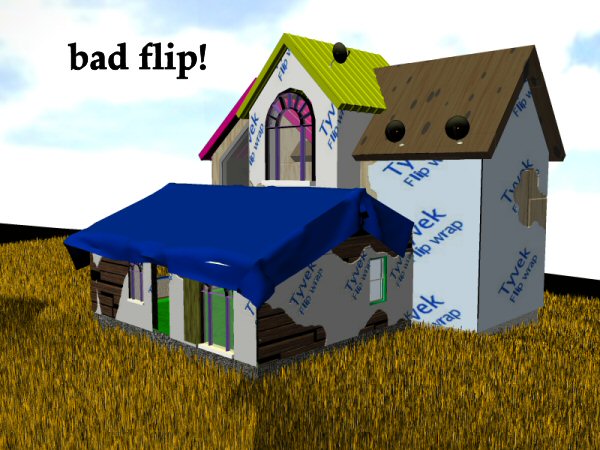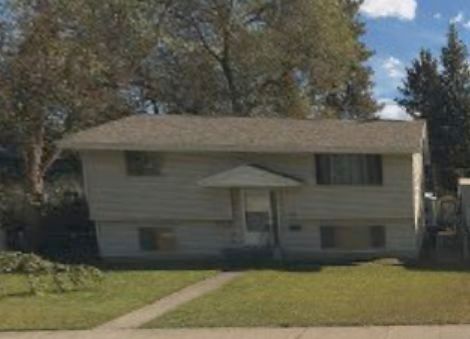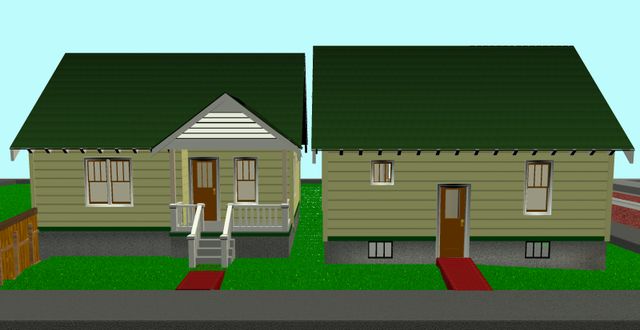Wednesday, March 07, 2018
Stupid random thoughts about split-levels
For some reason I was noticing split-level houses lately, and noticed that split-levels rarely get expanded.
Plain flat houses like the Default 50s house...
 ... nearly always get fancified ...
... nearly always get fancified ...
 ... and often get expanded on the back.
... and often get expanded on the back.
 But the Default 70s House...
But the Default 70s House...
 which is a bilevel, almost never gets expanded or added. There are at least 10K houses like this in Spokane, with the usual tract-house variations, but I've only seen one or two with side additions. None with back additions.
The floor height can't be the problem; flat houses have various heights, some with basement and some with slab. Renovators can always match the height closely enough, sometimes needing a bit of a ramp or slanty sill.
It must be the cantilevers. All of these Default 70s Houses have fairly large cantilevers on front and back, again with variations. There's no easy way to stuff a new foundation under the cantilevered part, and very few lots have enough space for a side addition.
As I was "pondering" this deeply serious topic, I realized: I've made digital models of many different flat and two-story houses, and one '60s trilevel, but never a bilevel. Is it worth trying to make a model?
But wait! I already made several bilevels! A bungalow with grade entry IS a bilevel. The only difference is that the modern bilevel has the grade entry on the front and the front stoop on the back. (Now called a deck.)
which is a bilevel, almost never gets expanded or added. There are at least 10K houses like this in Spokane, with the usual tract-house variations, but I've only seen one or two with side additions. None with back additions.
The floor height can't be the problem; flat houses have various heights, some with basement and some with slab. Renovators can always match the height closely enough, sometimes needing a bit of a ramp or slanty sill.
It must be the cantilevers. All of these Default 70s Houses have fairly large cantilevers on front and back, again with variations. There's no easy way to stuff a new foundation under the cantilevered part, and very few lots have enough space for a side addition.
As I was "pondering" this deeply serious topic, I realized: I've made digital models of many different flat and two-story houses, and one '60s trilevel, but never a bilevel. Is it worth trying to make a model?
But wait! I already made several bilevels! A bungalow with grade entry IS a bilevel. The only difference is that the modern bilevel has the grade entry on the front and the front stoop on the back. (Now called a deck.)
 Here's one of my bungalows forward and reversed. The reversed version on the right is a bilevel.
In other words, a bilevel is a Wolagnub.
Here's one of my bungalows forward and reversed. The reversed version on the right is a bilevel.
In other words, a bilevel is a Wolagnub.
 ... nearly always get fancified ...
... nearly always get fancified ...
 ... and often get expanded on the back.
... and often get expanded on the back.
 But the Default 70s House...
But the Default 70s House...
 which is a bilevel, almost never gets expanded or added. There are at least 10K houses like this in Spokane, with the usual tract-house variations, but I've only seen one or two with side additions. None with back additions.
The floor height can't be the problem; flat houses have various heights, some with basement and some with slab. Renovators can always match the height closely enough, sometimes needing a bit of a ramp or slanty sill.
It must be the cantilevers. All of these Default 70s Houses have fairly large cantilevers on front and back, again with variations. There's no easy way to stuff a new foundation under the cantilevered part, and very few lots have enough space for a side addition.
As I was "pondering" this deeply serious topic, I realized: I've made digital models of many different flat and two-story houses, and one '60s trilevel, but never a bilevel. Is it worth trying to make a model?
But wait! I already made several bilevels! A bungalow with grade entry IS a bilevel. The only difference is that the modern bilevel has the grade entry on the front and the front stoop on the back. (Now called a deck.)
which is a bilevel, almost never gets expanded or added. There are at least 10K houses like this in Spokane, with the usual tract-house variations, but I've only seen one or two with side additions. None with back additions.
The floor height can't be the problem; flat houses have various heights, some with basement and some with slab. Renovators can always match the height closely enough, sometimes needing a bit of a ramp or slanty sill.
It must be the cantilevers. All of these Default 70s Houses have fairly large cantilevers on front and back, again with variations. There's no easy way to stuff a new foundation under the cantilevered part, and very few lots have enough space for a side addition.
As I was "pondering" this deeply serious topic, I realized: I've made digital models of many different flat and two-story houses, and one '60s trilevel, but never a bilevel. Is it worth trying to make a model?
But wait! I already made several bilevels! A bungalow with grade entry IS a bilevel. The only difference is that the modern bilevel has the grade entry on the front and the front stoop on the back. (Now called a deck.)
 Here's one of my bungalows forward and reversed. The reversed version on the right is a bilevel.
In other words, a bilevel is a Wolagnub.
Here's one of my bungalows forward and reversed. The reversed version on the right is a bilevel.
In other words, a bilevel is a Wolagnub.
